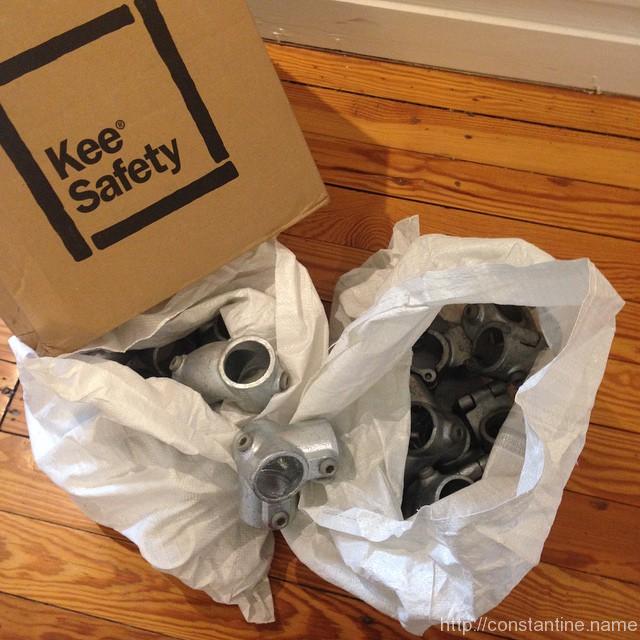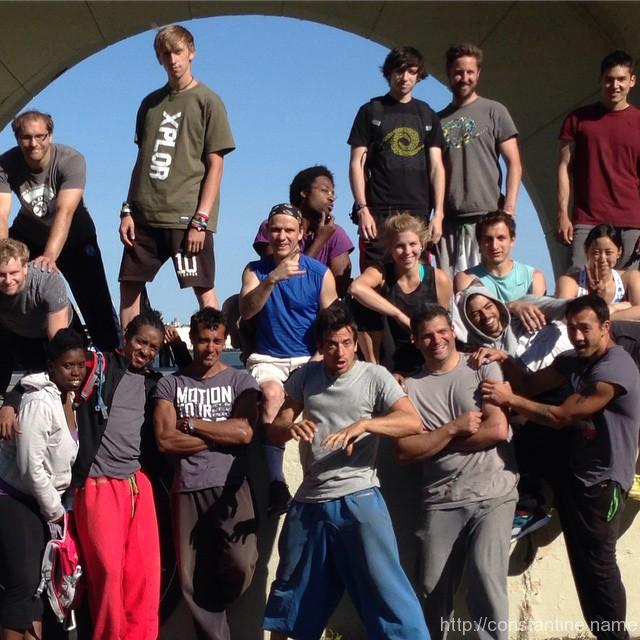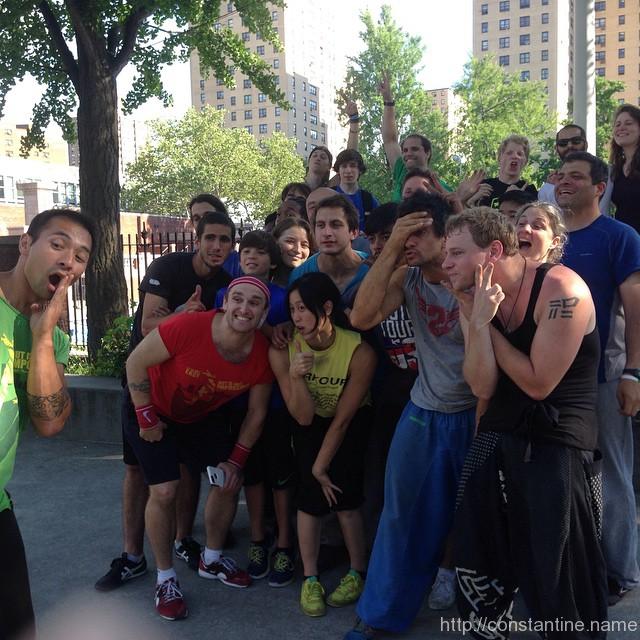In. The. Bag! …aaaand back to training.
ɕ
Parkour, Art du Deplacement, Free Running

In. The. Bag! …aaaand back to training.
ɕ

Tracy’s moving her turn-vault bar up inch by inch. My new project is bar-to-bar, near ground level and just slide them farther and farther apart. sketchy. (for me anyway)
ɕ
My guess is that we have all experienced this combination of effortlessness and effectiveness at some point in our lives. While we are completely absorbed in chopping and sautéing, a complex dinner simply assembles itself before our eyes. Fully relaxed, we breeze through an important job interview without even noticing how well it’s going. Our own experiences of the pleasure and power of spontaneity explain why these early Chinese stories are so appealing and also suggest that these thinkers were on to something important. Combining Chinese insights and modern science, we are now in a position to understand how such states can actually come about.
~ Edward Slingerland from, Trying Not to Try – Nautilus
slip:4unaiu1.
ɕ
Instead of specializing someone who is specialized in something else, we need to un-specialize them. We need to give people what they don’t have at the foundational level first. …
Once that foundation is established we’re able to move into almost any specialized activity, and that’s the goal. Not just to be good at exercising for a while, but to have bodies that are capable of doing whatever we want without injury in the real world, for the rest of our lives.
~ Matt Malloy from, «http://roguedenver.com/variability-fitness-training/»
ɕ

A while back I mentioned I’ve been experimenting with a FitBit HR and an intentional, designed, fitness program. I’ve been playing with this more. I originally didn’t like that I couldn’t just redefine all the zones to the HRs that we’re targeting.
Most, tradition/common workout programs I’ve seen have just 3 heart rate (HR) zones based on a maximum HR which is simply computed based on your age. The plan I’m working with from Mike, is significantly more complex. (Details for another post I suppose.) Anyway, the plan calls for very specific workouts, for example: “17 minutes in Z1”.
I noticed on day one, that the FitBit only has one “custom zone” that you can configure. So, I’ve begun manually setting the “custom zone” to the goal HR before some of the workouts. Once I plug in the specific Z1 lower/upper numbers, I can then set off on the workout.
On the device, there is an icon-based display that shows you quickly if you’re below/in/above the target zone. Normally, the icons refer to one of the FitBit’s built-in zones. But it turns out that if you set a custom zone, then the icon status is for your custom zone. Ok, now THAT’S useful!
The above screen grab is from a morning run where I had the custom zone set to my specific Z1 values. The graph shows the FitBit’s default zones (blue/”under”, yellow/”fat burn”, orange/”cardio”) and it overlays my custom zone as the hatched band. The bar graph even adds a value for the time in the custom zone.
In this example I set out to perform, after warming up, for 17 minutes in Z1. …and BAM! 16 minutes in Z1 by it’s measure. Now that’s a targeted workout.
Aside: The tail end of the graph was a strong-run-out, 1/4 mile. My opinion is that the FitBit sucks at picking up highend HR. Either that, or I’m a machine, and can run an 8 minute mile pace at a 151HR. …and it’s not the latter of those two.
ɕ

Next up… start learning some bio.
ɕ
The idea of what parkour can be and the current reality of what parkour is are not the same as far as who participates. The issue of gender can’t be ignored in parkour. You hear a lot based around the idea of ‘parkour is for everyone!’, well theoretically yes, but if all you really see is young guys then if you are not a ‘young guy’, it many not occur to you that it could also be for you. Parkour as an activity is not alone in this.
~ Julie Angel from, «http://www.goseeanddo.com/parkour-the-inconvenient-truth/»
ɕ

Tracy said, “I wanna’ work turn vaults…” BAM!
ɕ

Yeeee-Haw! The UPS driver, (aka ‘our brown Santa’,) just surprised me with this…. didn’t even know it had shipped! Off to Home Depot for steel pipe . . . *squeeeeeeeee*
ɕ

LVPK representing! So happy we got this trip in!
ɕ
WWII Workout Week concludes with some exercises you can do to improve your posture. While posture is an oft neglected part of physical training programs, it provides a myriad of benefits and can boost both your physiological functions and your confidence.
~ Brett McKay from, WWII Workout Week: Posture Training
slip:4uaowi4.
Circa 1946, from the Army field manual FM 21-20. ‘ten-HUT!
ɕ

In the bag. What an awesome group of people. Spirit all around…. what heart!!
ɕ
Art du Déplacement, (a French phrase meaning ‘art of movement’,) is a method of improving oneself through challenge. The founders say that to practice the art means to work toward: Being mentally and physically strong; being useful; being a positive contribution to your community; being better than you were yesterday.
But what about competition, flips, stunts, jumping roof gaps and gymnastics tumbling? …are those things part of it? Certainly, some people do those things as part of their practice. Competition can make you physically stronger. Jumping roof gaps can make you mentally tougher. So these things can be part of your practice, but your practice does not have to be these things.
For me, swallowing my pride and starting over in physical fitness with a group of people about half my age… That was a challenge. For me, pull-ups are a challenge. But that’s the whole point. It’s is about me improving me, and you improving you.
But I didn’t know that when I first tried Parkour, (before I understood the Art du Déplacement roots of what I was learning,) in the spring of 2012. I had met Adam McClellan during a martial arts demonstration and he talked me into coming out to play with the growing Lehigh Valley Parkour community. I am continuously delighted to be the big, old, slow, lumbering gorilla in a community of enthusiastic, supportive and happy people. After two years of serious training, at the age of 42, I passed the ADAPT Level 1 certification through Parkour Generations. Art du Déplacement, Parkour, and this unique community, have changed my life.
ɕ

This arrived at my office while I was away… awesome work Julie! Thank you so much for all the effort that went into this book.
ɕ
Instead of berating yourself when you’re not motivated to exercise, or getting mad at yourself when you struggle with eating unhealthy food, take a step back and look at it from a different angle:
“How can you build the habit of success and put your focus there, instead of chasing the motivation to make it happen?
It’s easy to become ensnared – to chase motivation and fail – or rationalize inaction and never try. Every single one of us has fallen into this trap. I’d love to hear about your experience with this, and how you plan to (or already have) overcome it.
~ Steve Kamb from, Is Motivation Useless?
slip:4unebo8.
In a vague sort of way, I found this idea in my own training. As usual, Steve Kamb brings clarity to the party. This idea of incremental actions, of habits, and little processes that make success a foregone conclusion is at the core of my Parkour training.
ɕ
So the explanation here is clear: Our skeletons, musculature and nervous systems are highly refined and well-coordinated adapative systems which adjust both instanteously and by means of longer term adjustments to in order handle the terrain. These “proprioceptive” adjustments take place virtually beneath the level of consciousness, through the exquisite feedback systems of our body and brain. Try to circumvent these systems, and the protective mechanisms will weaken, exposing us to injury.
~ Todd Becker from, The paradox of barefoot running
ɕ
So this happened in Cartegena.
This is funny, but that’s not why I posted this. See the bottom.
Imagine if you will, a bus load of 45 tourists — a perfect stereotype bus tour from a cruise ship. We all walk up a hill/road to see the Castillo overlooking Cartegena. (Very nice by the way! Photos coming soon.) Then we walk all the way back down. We reach an intersection, near our bus in the home stretch, and across the street is a small park with one of those long railings meant to keep people from J-walking.
The cross-walk says “go”, so there’s no traffic. Without thinking, I J-walked straight across and vaulted the rail.
…and I hear 44 people do a group groan. They had all followed me across the intersection and everyone had to walk all the way around the railing. (My mom shouted out, “Brat!”)
SO? Well, I did it without thinking, but FORGET ME.
Imagine what YOUR LIFE would be like if you vaulted a little railing after a long walk AND THOUGHT IT WAS FUN. What, really, is your excuse?
(…and if you’re in shape, or under 20, or can already vault a rail. Kudos to you! …but I’m not talking to you.)
ɕ

Some videos I took in April 2015 when I was last up in Somerville. This certainly isn’t a great answer to “what is parkour” in the global sense. But it will give you an idea of what I was working on when I had several hours to play on some scaffolding when I had unstructured time to just train.
ɕ

Group photo from the end of the “Gauntlet” event in Somerville.
I think my biggest accomplishment was the “didn’t hurt myself.” I certainly did a lot of physical things that were impressive (for me, and my ability.) But just being able to continue to ‘dig deep’ for hours on end — that was great.
As usual, I want to avoid name-dropping. But we did this one neat turn-vault landing on one foot and continuing on to step down and off the wall… that was something very different! Also, one of the first times I’ve EVER just “done” something and actually felt like I was really moving simply.
ɕ

I’m working with a friend of mine — Mike Bowyer — on a designed, intentional, training program. One of the critical components is working for specific times in very particular heart rate zones. So I’ve bitten the bullet, and am trying a FitBit. Online commentary seems to be that it’s not super-accurate, but I’m hoping it will do at least an ‘ok’ job of thoroughly recording heart rate during — saw this coming didn’t you? — parkour activities.
…until I smash it on a brick.
ɕ